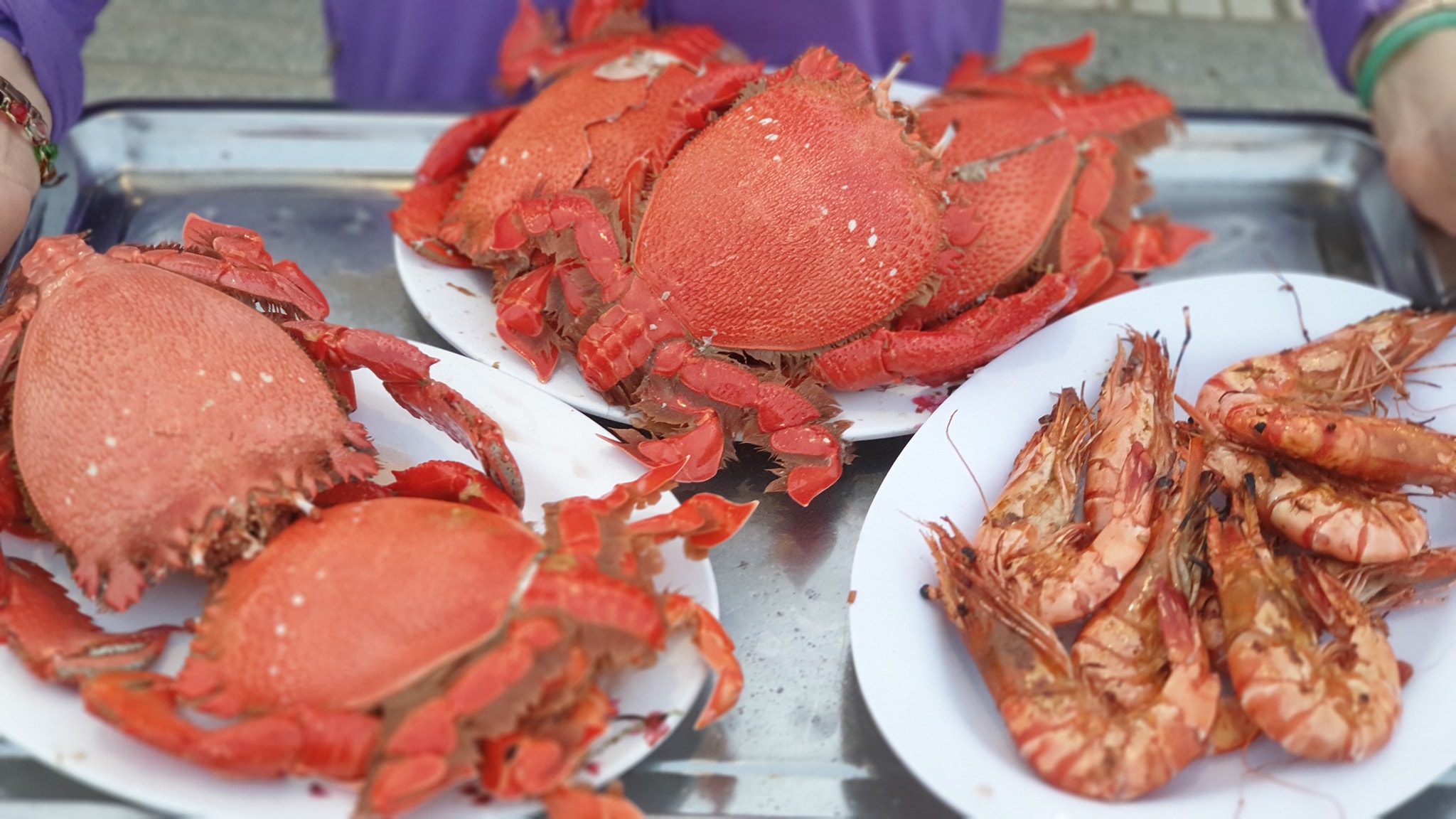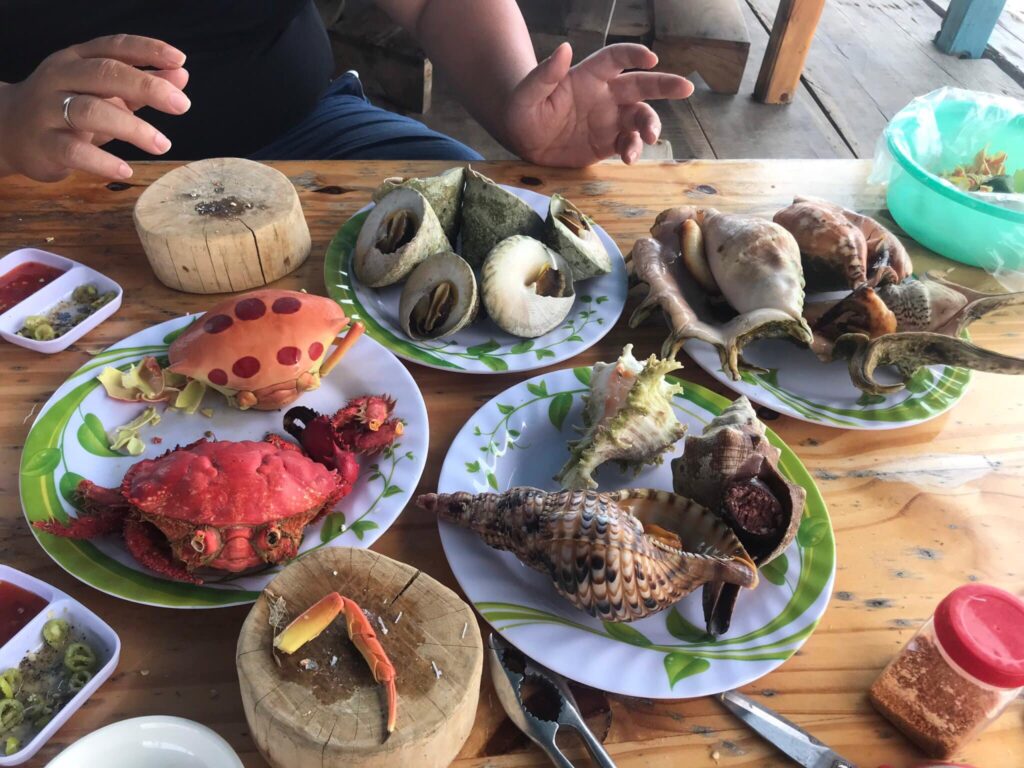When setting foot on Phu Quy Island, besides experiencing the local culture and exploring tourist destinations, one of the most sought-after delights by travelers is the island’s seafood cuisine. Some must-try specialties include: spiny king crab, moon crab, red grouper, spotted grouper, lobster, slipper lobster, sea snails, and more. All are prepared with fresh, natural ingredients from the sea, offering a unique flavor you shouldn’t miss when visiting this beautiful island.
Spiny King Crab
The spiny king crab is considered the first seafood delicacy you should try when visiting this small island. It’s no coincidence that it’s referred to as the “king of crabs.” This crab wears a hard, reddish-pink “armor,” resembling a warrior’s outfit, with tiny spikes along its body and large, sharp claws.
Its meat is as firm and flavorful as lobster, with rich and aromatic roe, packed with nutrients. In the past, this crab was served only to royalty during springtime feasts, hence the name “Emperor Crab.” However, to avoid name conflicts with the emperor, it was later changed to “Spiny King Crab.” Particularly, Phu Quy’s spiny king crab boasts a distinctive deliciousness.

According to culinary experts, to bring out the crab’s full flavor, it should be cooked with minimal seasoning—especially without cheese, butter, onion, or garlic. Discerning diners usually opt for two simple yet flavorful dishes: steamed spiny king crab served with green chili salt, and spiny king crab porridge.
Moon Crab
Many local fishermen say moon crabs are relatively easy to catch. Due to the large, moon-like spot on their shells, they are easy to spot. These crabs often hide in coral crevices and move very slowly, making them easy to catch even at night. About ten years ago, moon crabs were abundant, and fishermen could harvest 10–100 kg in a single night. However, in recent years, their numbers have declined. Fishermen now venture to nearby islets like Hon Trung, Hon Tranh, Hon Do, Hon Den, and Hon Hai to hunt them, pushing their price higher—ranging from 400,000 to 600,000 VND per kilogram, depending on size. Despite the high price, it’s not always easy to buy them since many restaurants pre-order in advance.
Visitors often seek out moon crab out of curiosity—and once they taste it, they’re hooked. The moon crab’s meat here is uniquely flavorful compared to other regions, justifying the slightly higher cost. To enjoy it, you usually have to reserve in advance. Unlike other sea crabs that require complex preparation, moon crabs are best simply steamed to retain their natural sweetness, boiled with coconut water for an extra touch of flavor, or grilled over hot charcoal for a heavenly aroma. These simple yet delightful dishes leave a lasting impression.
Dip a piece of crab meat into salt and lime (or Tay Ninh chili salt) and savor its natural sweetness—words can’t describe the taste! Even the claws and legs are full of tender meat. Unlike other crabs with hollow limbs, moon crabs have dense meat inside—just one suck brings a whole chunk of crab meat to your mouth. What a treat!
For the island’s fishing families, moon crab is even more precious than spiny king crab. During Tet (Lunar New Year), it’s often included on the ancestor altar along with a tray of fruits. When locals serve grilled moon crab to mainland guests, it shows the depth of their hospitality and respect.
Grouper
One of Phu Quy’s best-known specialties is grouper, a firm, flavorful fish—some weighing over a kilogram, plump and sweet. Grouper can be prepared in many ways: fried, cooked in sour soup, steamed, etc. But the standout dish is the simple grilled grouper, which has won over the hearts of countless visiting food lovers.
This dish has become one of Phu Quy’s signature culinary delights, thanks to its unique island flavor, hard to find anywhere else.
Grouper is not only rich in nutrients but also extremely tasty. You can make a variety of dishes like mustard grouper, hotpot, porridge, sour soup, and steamed grouper—but the most impressive remains the grilled version, which never fails to captivate travelers during their Phu Quy trip.
To prepare it, freshly caught grouper is cleaned, gutted, and grilled directly over hot coals. When just cooked, it emits an irresistible aroma. The fish’s firm white meat is served hot, chewy and rich with the briny taste of the sea. Its thin, crispy skin retains a hint of smoke. Dip it in Phu Quy’s famous fish sauce for an extra burst of flavor—it’s pure joy.
Many visitors have admitted that from the first bite, they became addicted to this simple, rustic, yet flavorful and irresistible island dish.
Slipper Lobster
Slipper lobster, also known as fan lobster, is a decapod crustacean found in warm seas and oceans. In some regions of Vietnam, locals call it “mu ni” because of its large antennae that resemble ear-flap hats. In Phu Quy, they are caught year-round. Among the island’s many unique seafood varieties, slipper lobster is a must-try specialty.
There are several types, with white and red slipper lobsters being the most commercially valuable. They are also featured in high-end restaurants. These lobsters have white, tender, and sweet meat with high nutritional value that is not overwhelming even when eaten in large amounts.
Since it’s such a premium ingredient, elaborate preparation is unnecessary. The simplest dishes include steamed slipper lobster, grilled with lemongrass, garlic, and chili, or salt-roasted. The most important requirement is freshness. When steamed or grilled, the shell turns golden while the inside remains tender and sweet. A bit of lime salt is enough to elevate the flavor.
For more sophisticated dishes, there’s butter-fried lobster or snow fungus-steamed lobster. Snow fungus is a highly nutritious food that boosts immune cell activity and helps prevent cancer. When combined with slipper lobster, it becomes a health-boosting dish. After the shell is cleaned, the lobster is steamed with some spices. Near the end, snow fungus is added and steamed for another five minutes.
The whole lobster is then served on a plate, with the shell cut open to reveal its pink outer layer and snow-white, tender, yet firm meat inside. The dish is even better with a touch of wasabi and a glass of wine.
Sea Snail
As a famous delicacy from Phu Quy’s coast, the sea snail—also known as emperor snail—is loved by food connoisseurs for its flavorful meat that can be turned into many delicious dishes.
Sea snails, or emperor snails, are large marine snails found throughout Asia’s coastal waters. In Vietnam, they have various local names like “ốc gáo” or “ốc giá,” depending on the region.
These snails live quite long, from 4 to 31 years. Mature ones can weigh 1.5–2 kg. They have large shells that resemble water ladles. Their meat is thick, divided into two parts: a translucent white, crunchy part, and a soft, light brown gut with a nutty taste.
In Phu Quy, Binh Thuan, it’s easy to find dishes made from sea snails.
When removing the meat from the shell, the cook must be skillful. Whether prying it out after boiling or cracking the shell to get the raw meat, they must remove the “hòn hôi” (a digestive gland) inside the snail.
The “hòn hôi” is similar to the bile in fish—it must be removed to avoid bitterness or fishy smell.
Sea snail meat can be boiled, grilled, stir-fried, steamed, turned into salad, or porridge. The simplest is boiled sea snail. The meat is cleaned to remove slime, then boiled, sliced thinly, and served with fish sauce mixed with ginger, garlic, and chili.
Sea snail salad is another must-try Phu Quy seafood dish. Only fresh snails that still secrete mucus are used—the drier ones are old and rubbery with an unpleasant smell. Sea snail meat is mixed with banana blossom, green mango, Vietnamese herbs like coriander, mint, onions… and seasoned with sugar, vinegar, fish sauce, chili, and pepper. Roasted peanuts and fried shallots may be added for extra flavor. Depending on the restaurant, it can be served with rice crackers or prawn crackers.










